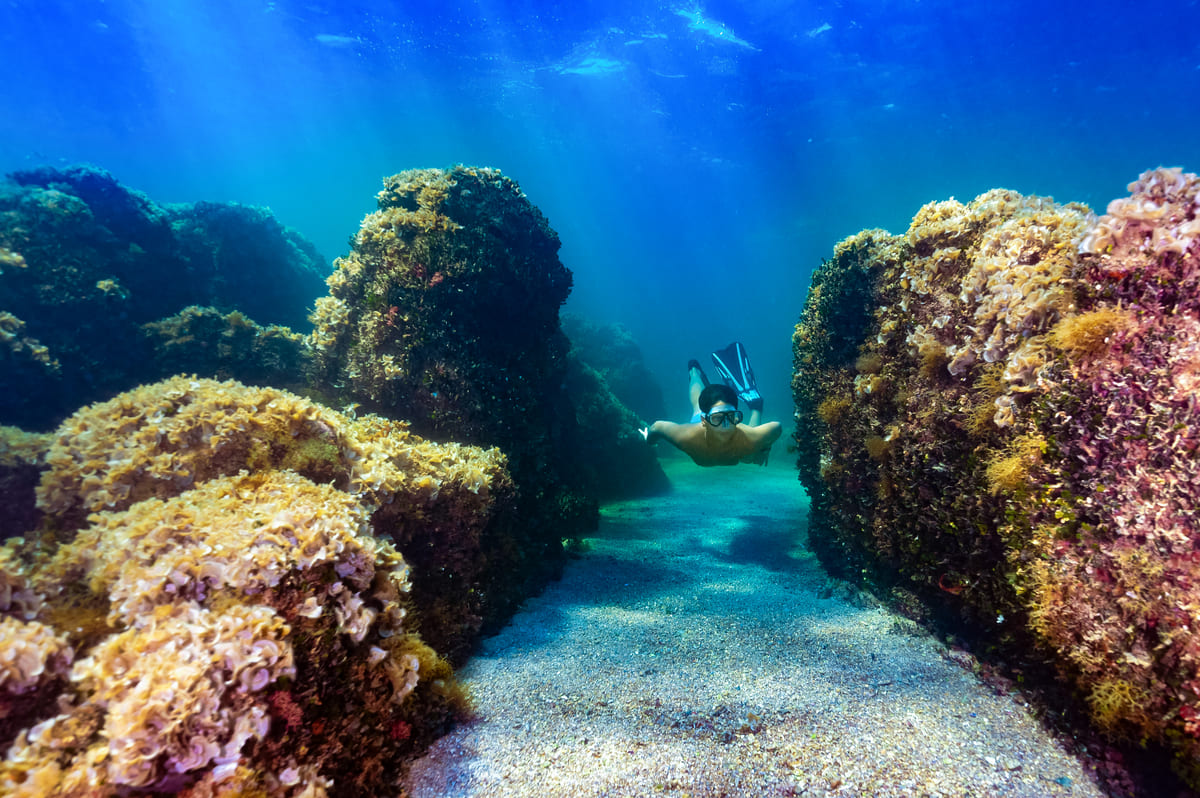The Adriatic like the Red Sea: snorkelling in Istria, along the Croatian coasts of the region, is the most exciting way to discover an unexpected underwater world.
Dove fare snorkeling in Istria
Underwater stone labyrinths, ancient piers under the water, remains of galleons, colonies of yellow seahorses that swim among the cliffs near the ports, caves populated by felonious crabs and brightly colored nudibranchs: there is all this , and much more, to be discovered by snorkelling in Istria, in the seabed of the Croatian peninsula that stretches out over the waters of the Adriatic Sea. An unexpected and beautiful underwater world, made even more accessible and easy to explore thanks to an avant-garde seabed mapping project: started last year, this initiative promoted by the Istrian Tourist Board and the pro loco, has made the seabed easily accessible even by non-diving experts: a mask and snorkel are enough and, thanks to the maps and indications on site, anyone can easily find the most beautiful and interesting sites, and explore them by snorkelling.
1. In Fažana (Fazana), swimming in the Roman port of Cape Mede
In the channel of the small town of Fažana (Fažana), which has been well protected from waves since ancient times, you can see the remains of a hook-shaped Roman pier (at a depth of 1-2 meters), where archaeologists have found amphorae and ceramic artifacts (Fazana was famous for the production of olive oil and wine).
From a fauna point of view, on this sandy seabed it is possible to meet fish such as the lyre gurnard, cuttlefish, dragon weevers, small spider crab, felony crabs and large oysters, which were regularly found on the menus of the ancient Romans.
2. On the trail of pirates in the Great Kolombarica cave, at Cape Promontore
At the extreme southern tip of Istria, at Cape Promontore (Kamenjak), there is perhaps one of the most exciting places to explore with fins, snorkel and goggles: the Great Kolombarica cave, which emerges from the water with a heart-shaped opening (here the doves nest and the cave itself takes its name from this detail).
It is recorded in the historical archives that pirates from Ulcinj (Ulcinj, in Montenegro) regularly reached Istria in the 3rd century BC with their sailing ships and it is most likely that this cave was used to hide the fruits of plundering boats. Today, in addition to the blue of the sea, the cave is colored by sponges and algae, and populated by conger eels, shrimps and crabs.
3. In Novigrad, swimming along the ancient walls
Another point not to be missed for snorkeling is the port of the pretty town of Novigrad (Cittanova), known for the Venetian walls that surround it. Snorkeling can start right from the walls, where there is a small beach with pebbles and rocks. Under the beacon, you can see brown algae (indicating clean waters), and then white bream, damselfish, schools of mullet and above all colonies of yellow seahorses.
4. Vrsar Lantern (Vrsar), or the lighthouse
The immersion that can be done in Vrsar (Vrsar) is exciting: in front of the town there is the most numerous archipelago of islands and islets in Istria, and here – about a nautical mile from the coast – there is also a lighthouse (Plić Mramori, simply called Lantern or Red Lantern). It can be reached by boat or SUP, and then start snorkelling at the base of the lighthouse, which teems with marine life: breams, damselfish, small blue fish which, like shepherds, chase after groups of bluefish (a relatively recent guest in the Adriatic and, due to milder winters and warmer seas, increasingly common).
For freediving experts, the exploration of the deepest boulders should not be missed because they hide traces of a distant past: here archaeologists have found evidence of Roman shipwrecks and the remains of a 15th or 16th century galleon. In the area you can see fragments of amphorae and nails with a square, wavy shape, an oxidized, greenish color, an integral part of a wooden ship.
5. In Pula (Pola), among scenic caves
Snorkelling starts from the beautiful rocky beach of Prirodno, not far from the Arena Stoja campsite in Pula: what you see emerging from the water is a sort of natural stone bridge, with three semi-open caves, two of which the sea enters.
Under water, however, the show continues among coral groves and rocks populated by sea dates (a protected mollusc).
6. Among the colors and fish of Rabac (Port Albona)
In the eastern part of the Istrian peninsula, in the Kvarner gulf, there is an interesting snorkeling spot called Girandella: as you approach the cliff of rocks that plunge into the turquoise sea, you will notice formations resembling the vertebrae of a dinosaur. The reef extends deep as a long wall interspersed with colorful cracks, inhabited by sponges of various colors and adorned with seaweeds of different colors.
The reef is very rich in fauna: you can see salepa fry, which can be recognized by the golden yellow stripes and yellow eyes, and silver mullet fry, which occasionally visit the area. Among the permanent inhabitants there are also bream pizzuti, sea bream, sea bass and smaller fish such as castagnole, sciarrani, donzelle and saddled bream.
READ ALSO:
All the marine beauties of Istria to discover
Diving: 8 tips to get you started
4 tips to start snorkelling
Advertising
